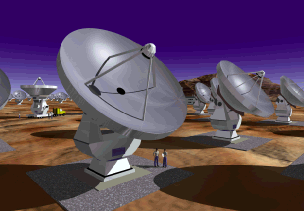
 |
ALMA Calibration Discussion Group Phone Meeting 2002-11-15
|
Attendance: Brogan, Guilloteau, Gurwell, Hasegawa, Holdaway, Lucas, Martin-Pintado, Momose, Mundy, Pety, Richer, Saito, Woody, Wootten, Wright
The Minutes of the last meeting were accepted. Cernicharo has sent in a review of Memo No. 415 which will be circulated, the status of others is unknown. Review of Memo 423 would be very timely; Guilloteau will publish it in the memo series to ease access. Wootten will remind Myers and Blake that they agreed to review this memo. Wootten noted that the Calibration section of the ASAC report was in the agenda, with the full report to be published momentarily.
Wootten briefly reviewed the milestones--what they are and how they are controlled. After briefly commenting on the Configuration status, he turned to a discussion of the Calibration Milestones, which occupied the majority of the meeting.
The first milestone involves the establishment of calibration requirements from science examples. These are currently being sought from the ASAC and other sources. Guilloteau will send the ALMACal group a copy of his email with some examples.
Wootten mentioned a report received from Douglas Bock at Berkeley on the dual load calibration system undergoing tests at BIMA. New hardware has been constructed to enable tests to confirm the stability of the coupling coefficient, and to evaluate the reliability with which it can be measured. BIMA hopes to do this within weeks.
There was some discussion of the status of the semi-transparent vane device. Japan will also use a similar device for the ASTE system; comment was made that an exchange of information on design and materials as well as results would be useful. Martin-Pintado stated that the test plan for implementation of a device on the 30m would be available within a week or so. Reviews of Memo 423 would be very useful in formulating these tests, Guilloteau noted. Woody inquired about the nature of the tests, to which Martin-Pintado replied that the results would be compared to the current hot and cold load system. Woody noted that an interferometer might provide a better test. It was pointed out that the excellent 30m wobbler system should enable a test with 1% accuracy. Martin-Pintado noted that among the tests would be tests of polarization effects, for which specifications would be extremely useful. Science examples which can help to set the polarization requirements would be especially useful. Wootten noted that the planning of devices to fit in the 'widget space' was well along, and that requirements needed to be set for the 'polarization widget' in a timely manner, which could also be drawn from polarization science examples.
In conjunction with Milestone II.C.3.f.i Wootten noted that the agenda for a workshop on calibration strategies with the Herschel HIFI team was attached to the agenda. Interested parties are urged to consult this and make their plans if they wish to attend. A report from this workshop will be used to help formulate ALMA strategy, particularly amplitude calibration.
Wootten noted that the calibration tests planned for the ATF interferometer were contingent on the availability of the interferometer itself, as its planning was underway.
Richer noted that the WVR group had reviewed the Section II-D WVR-related milestones and that they were compiling a more detailed response, but that the framework in the Science IPT plan was generally similar to the WVR Group plan.
Hasegawa confirmed that a Japanese group is working on detailed specifications for the ACA, to deliver a draft plan to be reviewed by March 2003.
This coming week meetings will be held in Charlottesville to consider photonic options for the LO on ALMA, and to set Specifications for Receivers. The NA Imaging and Calibration Group has been discussing in particular the specifications for gain stability in receivers. A collection of relevant documents may be found at the agenda for their 5 November meeting. Comments on this subject are welcome for the meeting next week.